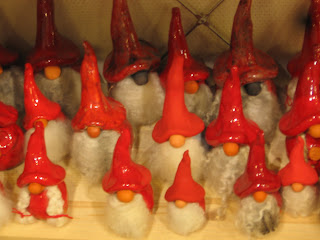Swedish folklore is dominated by tales of two different varieties of supernatural being: the troll and the tomte. These two beings possess contradictory personalities; while the troll is an ugly, grumpy, and malevolent being prone to kidnapping young children and replacing them with their own, the tomte is a friendly and bearded chap happy to help with cleaning and other household chores.
Belief in such creatures likely dates way back into pre-christian times. It has been suggested that tales of these supernatural beings are rooted in ancient forms of ancestor worship, surviving through the years in the guise of folk stories and superstitions.
But where are the trolls and tomtar now?

Today the troll and tomte have become cultural icons in Sweden (very much like the Leprechaun in Ireland and Nessie in Scotland), and perhaps the best place to spot them in the modern world is in the tourist gift shops, far from their traditional woodland and mountain homes. Indeed an industry has grown up around these supernatural beings; manifested through mass-production and lined up on shop shelves. In this respect it might be true to say that the trolls and tomtar are more abundant today, in this secularised and consumer driven society, than ever before, only that they are diminished in their power. Their supernatural agency has been removed, leaving only a plastic shadow of what they once were*.
In the process of humanisation in which the wild home of the trolls was domesticated (as expressed in the extract from the folk tale "When Mother Troll took in the King's Washing"), these supernatural entities have been pushed to the very brink: right onto the shop-shelf. As when the troll turns to stone in the daylight, now these ancient nature spirits have turned to plastic in the face of consumerism and modern tourism. Their habitat has been greatly reduced, and with it their power.
Their presence is, nevertheless, still very much in evidence.
"William never spoke for he stood turned to stone as he stooped; and Bert and Tom were stuck like rocks as they looked at him. And there they stand to this day, all alone, unless the birds perch on them; for trolls, as you probably know, must be underground before dawn, or they go back to the stuff of the mountains they are made of, and never move again. This is what had happened to Bert and Tom and William."
(J.R.R Tolkien, The Hobbit)
* Interestingly the tomtar statuettes often come with slips of paper explaining how "every home should have one" because they bring luck and help with the chores while the the household is asleep. The agency of the tomtar has, to some extent, been sustained. Transformed into a sort of fetish or effigy.

















